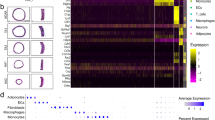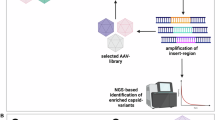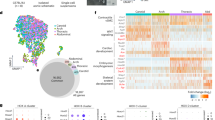Abstract
Previously, we demonstrated that recombinant Semliki Forest virus (SFV) vector rapidly and selectively transfers genes into cultured vascular smooth muscle cells (VSMC), leaving endothelial cells (EC) unaffected. From this, we hypothesized that recombinant SFV in vivo only transfers genes into the media of balloon-injured but not intact vessel, that gene expression in VSMC is fast, and that the specificity of SFV for VSMC is caused by specific binding sites. To address these hypotheses, we studied the time course of in vivo SFV-LacZ and Ad-LacZ expression in balloon-injured rat aorta. In addition, the fusion characteristics of fluorescent pyrene-labeled SFV were explored in cultured VSMC and EC. In intact aorta, no LacZ expression was found in the intima or media at 24 h. In contrast, in denuded aorta, LacZ expression was detected in as early as 12 h after incubation. LacZ expression was predominantly present in the media. Ad-LacZ expression started after 12 h, but was predominantly present in the adventitia. Ad-LacZ expression in the media started after 72 h. In vitro transfection with SFV showed that fusion was higher and, moreover, saturable in VSMC as compared with EC, indicating the presence of specific SFV binding sites on VSMC, but not EC. From this we conclude that in vivo selectivity of SFV in balloon-injured vessels is based on the removal of the endothelium, which results in accessibility of VSMC in the media that carry specific binding sites for the SFV vector.
This is a preview of subscription content, access via your institution
Access options
Subscribe to this journal
Receive 6 print issues and online access
$259.00 per year
only $43.17 per issue
Buy this article
- Purchase on SpringerLink
- Instant access to full article PDF
Prices may be subject to local taxes which are calculated during checkout




Similar content being viewed by others
References
Feldman L.J., Tahlil O., Steg G. . Perspectives of arterial gene therapy for the prevention of restenosis Cardiovasc Res 1996 32: 194 194
Feldman L.J., Steg G. . Optimal techniques for arterial gene transfer Cardiovasc Res 1997 35: 391 391
Roks A.J.M. et al. Vectors based on Semliki Forest virus for rapid and efficient gene transfer into non-endothelial cardiovascular cells: comparison to adenovirus Cardiovasc Res 1997 35: 498 498
Sjöberg E.M., Suomalainen M., Garoff H. . A significantly improved Semliki Forest virus expression system based on translation enhancer segments from the viral capsid gene Bio/technol 1994 12: 1127 1127
Liljeström P., Garoff H. . A new generation of animal cell expression vectors based on the Semliki Forest virus replicon Bio/technol 1991 9: 1356 1356
Berglund P. et al. Semliki Forest virus expression system: production of conditionally infectious recombinant particles Bio/technol 1993 11: 916 916
Smerdou C., Liljeström P. . Two-helper RNA system for production of recombinant Semliki Forest virus particles J Virol 1993 73: 1535 1535
Schulick A.H. et al. Endothelium-specific in vivo gene transfer Circ Res 1995 77: 475 475
Kim S. et al. Transcriptional targeting of replication-defective adenovirus transgene expression to smooth muscle cells in vivo J Clin Invest 1997 100: 1006 1006
Soiluhänninen M. et al. Semliki forest virus infects mouse brain endothelial cells and causes blood–brain barrier damage J Virol 1994 68: 6291 6291
Atkins G.J., Sheahan B.J., Liljeström P. . The molecular pathogenesis of Semliki Forest virus: a model virus made useful? J Gen Virol 1999 80: 2287 2287
Varenne O. et al. Percutaneous adenoviral gene transfer into porcine coronary arteries: is catheter-based gene delivery adapted to coronary circulation? Hum Gene Ther 1999 10: 1105 1105
Bult H. . Restenosis: a challenge for pharmacology Trends Pharmacol Sci 2000 21: 274 274
Lee S.W. et al. In vivo adenoviral vector-mediated gene transfer into balloon-injured rat carotid arteries Circ Res 1993 73: 797 797
Kafri T. et al. Cellular immune response to adenoviral vector infected cells does not require de novo viral gene expression: implications for gene therapy Proc Natl Acad Sci USA 1998 95: 11377 11377
Dryga S.A., Dryga O.A., Schlesinger S. . Identification of mutations in a Sindbis virus variant able to establish persistant infection in BHK cells: the importance of a mutation in the nsP2 gene Virology 1997 228: 74 74
Scallan M.F., Allsopp T.E., Fazakerley J.K. . Bcl-2 acts early to restrict Semliki Forest virus replication and delays virus-induced programmed cell death J Virol 1997 71: 1583 1583
Haisma H.J. et al. Targeting of adenoviral vectors through a bispecific single-chain antibody Cancer Gene Ther 2000 7: 901 901
Stegmann T. et al. Evaluation of viral membrane fusion assays. Comparison of the octadecylrhodamine dequenching assay with the pyrene excimer assay Biochemistry 1993 32: 11130 11130
Filipeanu C.M., Henning R.H., de Zeeuw D., Nelemans A. . Intracellular angiotensin II and cell growth of vascular smooth muscle cells Br J Pharmacol 2001 132: 1590 1590
Acknowledgements
We are very grateful to Hans Bartels, Alexandra Beuving, Martin Houwertjes, Gera Kamps, Bianca Meijeringh, Egbert Scholtens, Lucia van der Veen, and Jetti van Wijk, for their technical support. We thank Dr A Suurmeijer of the Department of Pathology, University Hospital Groningen for his useful suggestions. Further, we thank Medtronic-Bakken Research Maastricht, Inex Pharmaceuticals (grant to J Wilschut), and the Netherlands Heart Foundation (ICIN grant No. 295-0019 to Dr RA Tio) for their financial support.
Author information
Authors and Affiliations
Rights and permissions
About this article
Cite this article
Roks, A., Henning, R., Buikema, H. et al. Recombinant Semliki Forest virus as a vector system for fast and selective in vivo gene delivery into balloon-injured rat aorta. Gene Ther 9, 95–101 (2002). https://doi.org/10.1038/sj.gt.3301632
Received:
Accepted:
Published:
Issue date:
DOI: https://doi.org/10.1038/sj.gt.3301632
Keywords
This article is cited by
-
Induction of specific human primary immune responses to a Semliki Forest virus?based tumor vaccine in a Trimera mouse model
Cancer Immunology, Immunotherapy (2005)
-
Post-intervention vessel remodeling
Gene Therapy (2002)



